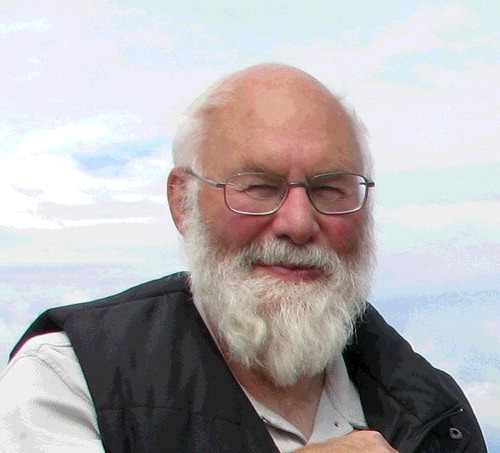Art Sweet passed away peacefully at his home on March 5th 2017 at the age of 74. He was an exceptional geologist and palynologist, and will be greatly missed by all of those whose lives he touched. Art had a remarkable scientific career in which he authored or co-authored at least 119 professional publications, 127 abstracts/posters at scientific meetings and 390 Geological Survey of Canada (GSC) internal reports on ∼4700 samples (see online supplementary information). Additionally, Art personally collected over 12,500 outcrop and well samples between 1967 and 2015. This tally of publications, reports and samples document his contribution to Canadian geology and palynology, to ‘K-T’ (now K-Pg) boundary studies, and to the research and careers of his collaborators and colleagues.
Art was always generous to others with his time and expertise, and invariably kind and thoughtful to colleagues, students, and newcomers. He developed long lasting and fruitful relationships in science, helping many people start their careers and often extended hospitality to out-of-town visitors. His open office door was pasted with jokes and a sign which read “a clean desk is a sign of absolutely nothing else to do.” Few days went by when Art did not have a colleague or visitor seeking advice from his extensive knowledge of Mesozoic and Cenozoic palynology and stratigraphy. He was gracious and patient throughout innumerable interruptions; the best sort of mentor that students, or junior colleagues, could have.
Art Sweet was born in Lloydminster, Saskatchewan, Canada in November 1942. Berry picking, grouse hunting and fishing during his childhood on the family farm on Gull Lake, Alberta, stimulated his interest in the natural world. He started his education in a one-room schoolhouse, later earning a BSc from the University of Alberta in 1963. Art worked as a geological assistant and science teacher until completing his PhD on Azolla and Azollopsis in 1972 at the University of Calgary, under the guidance of Len Hills. From 1969 to 1971, he held the Izaak Walton Killam Memorial Award for doctoral students of outstanding caliber. In 1972, Art started as a Research Scientist at the Geological Survey of Canada (GSC), for a year in Ottawa and then in Calgary at the Institute of Sedimentary and Petroleum Geology (now GSC-Calgary), where he remained throughout his career. Art married his wife, Alberta, in 1966 and they have three children, David, Patrick and Karilynn, and seven grandchildren. They kept a productive garden in Calgary and raised honey bees at their cabin near Olds, Alberta. His children clearly recall the values that he instilled in them, i.e “family first, work hard, be self-sufficient, be kind and humble, sit up straight and smile.”
At the GSC, Art first worked on Late Jurassic and Early Cretaceous terrestrial palynofloras. He was soon drawn to study the incredible diversification of angiosperms during the Cretaceous, and the post ‘K-T’ boundary flora of the Paleogene. His objective was to understand angiosperm pollen phylogenies, and to develop more refined biostratigraphies for western and northern Canada, often with synergistic collaboration from paleomagnetic studies. Art's encyclopedic memory, for both literature and for pollen and spore specimens and taxa, made him a scientist well suited to explore this diverse and formative interval of angiosperm development. Art found the ‘K-T’ boundary and contiguous strata particularly fascinating, and completed meticulous investigations of many boundary sections in western and northern Canada elucidating both stratigraphic and latitudinal changes in flora and vegetation. In later years, his biostratigraphic knowledge was applied to fossiliferous sedimentary clasts within kimberlites to derive a record of now-eroded sedimentary rock that once covered the Slave Craton. From 2002 to 2008, he served as Chief Paleontologist and Paleolab Leader at the GSC. His most recent research focused on Albian through Paleogene strata of Bylot Island, Yukon and the Northwest Territories.
Art was a principled and thorough scientist who was dedicated to the disciplines of geology and palynology, seeming to pack two careers of devoted work into one lifetime. At the start of the working day, it was routine to find Art already in his office, having arrived as early as 3 or 4 am, and often returning to the office late in the evening. Evenings at home were often spent writing papers, or completing reviews for journals. He continued to work past formal retirement age until ill-health began to limit him. Art said that he would like to think his was a “life of service and a life of science”, and has been honored with the naming of two species. The first is a fungal spore Diplodites sweetii (Kalgutkar et al., 1993. Review of Palaeobotany and Palynology, v. 77, p. 107–118), “in recognition of his outstanding contribution to Tertiary palynology and his significant role in the understanding and interpretation of the K-T boundary.” The second is the pollen grain Parviprojectus sweetii (White, 2009. Geological Survey of Canada Bulletin 594) dedicated for his “career-long fascination with triprojectate pollen.”

